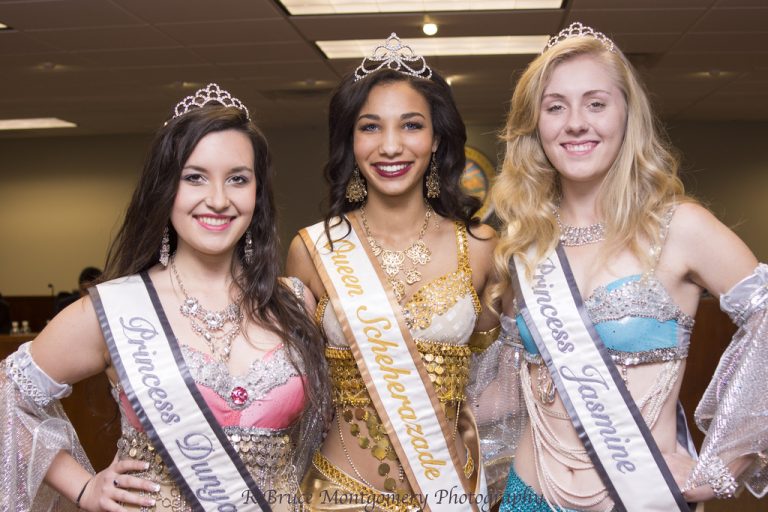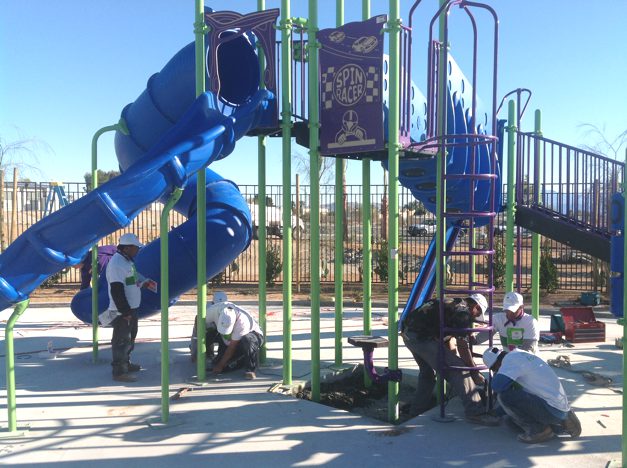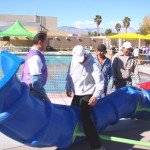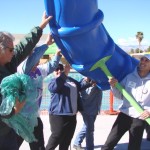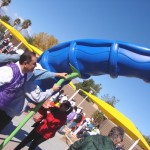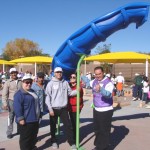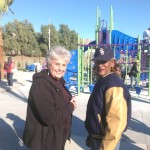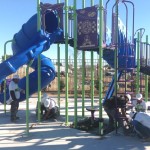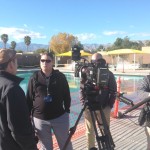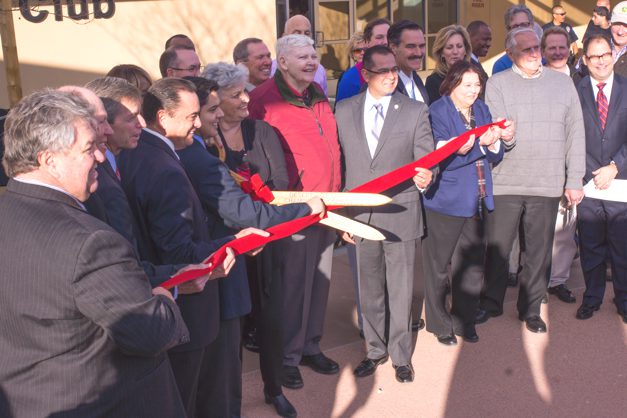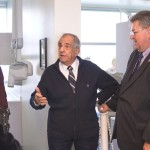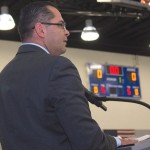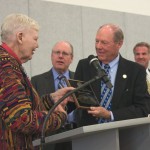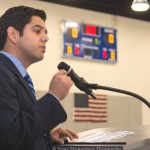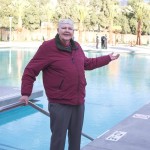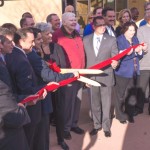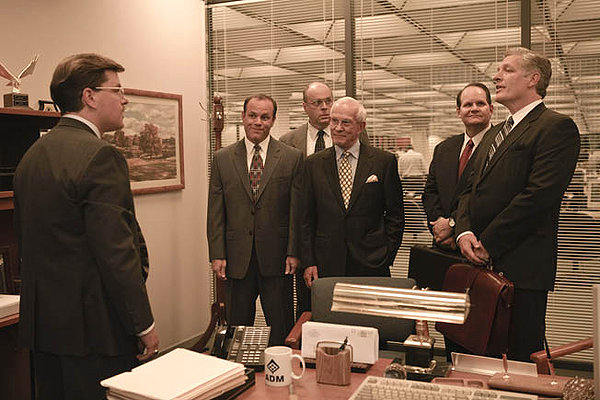The Regular Meeting of the Desert Hot Springs City Council was held on Tuesday, January 15, 2013 at the Carl May Center. Presentations were made by Chris Cunningham, Desert Valley Disposal; Heather Coladonato Chamber of Commerce Executive Director Heather Coladonato; the 2013 Date Festival Queen and her court; Code Enforcement Manager Hart Ponder; and two members of DHSPD Special Enforcement Team (SET). More photos by Bruce -Slideshow
Jan. 15, 2013 City Council Meeting
Kaboom
The community of Desert Hot Springs came together to build a “Kaboom” playground at the newly opened Community Health and Wellness Center. A record 380 volunteers completed the project in half an hour less than the anticipated time it would take to build it. Way to go, Desert Hot Springs!
Grand Opening of DHS Health and Wellness Center
Residents of Desert Hot Springs and leadership from across the valley and county turned out in large numbers to witness the Grand Opening of the Desert Hot Springs Community Health and Wellness Center, located at 11-750 Cholla Drive.
Emcee Patrick Evans, weather anchor for CBS Local 2 was emcee. The DHSHS Marine Corps JROTC Color Guard presented colors, and Dezarae Porcho (a member of the Boys and Girls Club) led in the pledge of allegiance, followed by a solo of teh National Anthem by another club member.
Mayor Yvonne Parks welcomed the crowd, then Pastor Bruce Montgomery gave the invocation.
Speakers were Congressman Raul Ruiz, MD, House of Representatives – California’s 36th District, California State Assemblyman V. Manuel Perez, Riverside County Supervisor John Benoit, Desert Healthcare District Board of Directors President Dr. Glen Grayman, and Honorable Judge Douglas Miller, who is President of the Board of Directors of the Boys and Girls Clubs of Coachella Valley.
Supervisor Marion Ashley presented a recognition of John Furbee, and the benediction was given by Police Chaplain Paul Miller. Following closing remarks by Mayor Parks, ribbon cuttings were held for both the Health and Wellness Center and the Boys and Girls Club, and there was a reception in the wellness room and an open house of the entire facility, which includes state of the art dental offices.
All photos by Bruce Montgomery.
Ambiguous And Complex Documentary Film Screens At Psiff

The Palm Springs International Film Festival (PSIFF) usually attracts a large contingent of documentary film entries (some sixty plus). Documentary filmmakers are drawn to this festival as are moths to a flame. If you want your “docu” to be seen, then PSIFF is the 800-pound gorilla when it comes to audience exposure. But they only accept the best for consideration.
In the documentary film “The Informant”, by writer/director Jamie Meltzer, we have an opportunity to examine and explore the motivations of an obviously duplicitous individual whom the program notes say is based on a true story. Brandon Darby starts out as a left-wing political activist, who claims to have “seen the light” somewhere along the way, and who then turns 180 degrees, and offers himself as an FBI informant.
 The program notes also say the film is possibly the year’s best thinking man’s who-done-it. Why? Well, because we already know “Who done it”. The larger question is: can we trust Mr. Darby’s veracity? Could he be a triple agent? In today’s politically intriguing and highly charged intelligence community, any hypothesis is possible.
The program notes also say the film is possibly the year’s best thinking man’s who-done-it. Why? Well, because we already know “Who done it”. The larger question is: can we trust Mr. Darby’s veracity? Could he be a triple agent? In today’s politically intriguing and highly charged intelligence community, any hypothesis is possible.
Director Meltzer, a seasoned filmmaker, spent three years interviewing and filming Bandon Darby. He also spent over $150,00 dollars in bringing Darby’s story to the screen. Darby began as a charismatic activist who worked with the homeless of New Orleans’ Ninth Ward following Hurricane Katrina. You have some people saying Darby was a true friend of the Ninth Ward and a “do-gooder” that got things done.
On the flip side, there are those who vilify him as the FBI informant largely responsible for the imprisonment of two young activists following the 2008 Republican National Convention. The young men insinuate that Darby misled them into performing violent acts. They say they never would have gone that far on their own. Also, they claim the government entrapped them with Darby’s help. The case of the two young men is still ongoing.
 Meltzer painstakingly constructs his documentary with on-camera interviews with friends and acquaintances of Darby, even re-creating enactments with them and with Darby himself. Some on the Left feel betrayed by Darby’s switch to the “dark side”. Translation: to the Right. Darby now represents some elements of the Tea Bag Party by speaking at rally’s and other gatherings. He’s been likened to a glory hound, not only in the pursuit of his new agenda, but also in the pursuit of money. There’s nothing new in that position. Many have gone down that path before, and still many will follow him down that road again.
Meltzer painstakingly constructs his documentary with on-camera interviews with friends and acquaintances of Darby, even re-creating enactments with them and with Darby himself. Some on the Left feel betrayed by Darby’s switch to the “dark side”. Translation: to the Right. Darby now represents some elements of the Tea Bag Party by speaking at rally’s and other gatherings. He’s been likened to a glory hound, not only in the pursuit of his new agenda, but also in the pursuit of money. There’s nothing new in that position. Many have gone down that path before, and still many will follow him down that road again.
When Meltzer is asked by an audience member during the Q & A what his honest opinion is, as to which Darby version of the truth one should believe, he responds with “Well, that’s up to the audience to decide.” He goes on to say that he purposely left the ending of film sort of dangling in an ambiguous state. The conundrum proffered by the film is somewhat similar to what a Judge must face in a court of law on a daily basis: Which side is really telling the truth? Of course, the government and the FBI are in support of Darby becoming patriot and a supporter of the law.
 Since his Epiphany Darby has been ostracized by his former fellow activists as a pariah, and he’s received death threats by people he’s doesn’t know or has never met. He now sleeps with a gun under his pillow. One thing we do know, Brandon Darby is now a man who is continually looking over his shoulder. The life of an informant is not a very rosy one
Since his Epiphany Darby has been ostracized by his former fellow activists as a pariah, and he’s received death threats by people he’s doesn’t know or has never met. He now sleeps with a gun under his pillow. One thing we do know, Brandon Darby is now a man who is continually looking over his shoulder. The life of an informant is not a very rosy one
German Suspense Thriller Screens At Palm Springs Film Festival

When spy or suspense thrillers from Germany are released these days, comparisons, no matter how odious, are inevitable. Germany’s Oscar Winning 2011 Best Foreign Language film “The Lives of Others” is the gold standard when it comes to judging life as it was lived in the German Democratic Republic (East Germany) before the fall of the Berlin Wall in 1989 (although Le Carre’s “The Spy Who Came in from the Cold” is a formidable contender).
Christian Petzold, one of Germany’s finest film directors, presents an insightful drama and character study in his screen story “Barbara”. It’s a film about the effect of constantly being under suspicion and under scrutiny and how long-term repression plays on a society.
 “Barbara” is not a classic spy story. Instead, we’re dealing with a brilliant East German, Berlin-based doctor in 1980, who has been punished by officials for applying for an exit visa to the West. As a result, Barbara (Nina Hoss) is reassigned to a small hospital in the provinces off the Baltic Sea. Here she works under the supervision of Dr. Reiser (Ronald Zehrfeld), and under the constant scrutiny of Shutz, the local Stassi agent (Rainer Bock). Schutz goes so far as to break into Barbara’s small, drab apartment, at all hours, even going so far as to have Barbara undergo body and cavity searches as a method of humiliating and conditioning her; perhaps, in the hope of finding contraband in the process.
“Barbara” is not a classic spy story. Instead, we’re dealing with a brilliant East German, Berlin-based doctor in 1980, who has been punished by officials for applying for an exit visa to the West. As a result, Barbara (Nina Hoss) is reassigned to a small hospital in the provinces off the Baltic Sea. Here she works under the supervision of Dr. Reiser (Ronald Zehrfeld), and under the constant scrutiny of Shutz, the local Stassi agent (Rainer Bock). Schutz goes so far as to break into Barbara’s small, drab apartment, at all hours, even going so far as to have Barbara undergo body and cavity searches as a method of humiliating and conditioning her; perhaps, in the hope of finding contraband in the process.
 Barbara is coolly played by Nina Hoss, one of Germany’s finest stage actors. She delivers an aware, but guarded portrait of an individual who knows she’s under surveillance. She even challenges Dr. Reiser at one point, asking if he is getting his reports on her to Schutz on time. Reiser, is drawn to Barbara both in a professional manner and is intrigued by her private life. He sees no man in her life. Perhaps there is spot for him?
Barbara is coolly played by Nina Hoss, one of Germany’s finest stage actors. She delivers an aware, but guarded portrait of an individual who knows she’s under surveillance. She even challenges Dr. Reiser at one point, asking if he is getting his reports on her to Schutz on time. Reiser, is drawn to Barbara both in a professional manner and is intrigued by her private life. He sees no man in her life. Perhaps there is spot for him?
Barbara has a West German businessman boyfriend (Mark Weaschke) who secretly visits her from time to time. Together they plan her escape to the west. But before that happens Stella (Jasna Fritz-Bauer) a young, orphaned patient, shows up at the hospital suffering and complaining which Dr. Reiser misdiagnoses. Barbara intervenes, and quickly and correctly diagnoses that Stella has meningitis. From then on she takes both a medical and a personal interest in Stella – a decision that will alter Barbara’s life forever.
 Filmed in color (a departure from films with East German story settings) by Hans Fromm, the colorful North Sea country landscapes belie the grittiness and grime of urban East Germany. The pacing by Petzold borders on glacial, but that’s not necessarily a detriment. It affords the viewer plenty of time for introspection as well as those of the characters. The actors, are all solid in their portrayals bringing a ring of authenticity that is critical in accepting Petzold’s premise: long-term oppression by a police state government is patently life-destroying.
Filmed in color (a departure from films with East German story settings) by Hans Fromm, the colorful North Sea country landscapes belie the grittiness and grime of urban East Germany. The pacing by Petzold borders on glacial, but that’s not necessarily a detriment. It affords the viewer plenty of time for introspection as well as those of the characters. The actors, are all solid in their portrayals bringing a ring of authenticity that is critical in accepting Petzold’s premise: long-term oppression by a police state government is patently life-destroying.
Films from Germany over the last 20 years are still in expiation mode. As interesting as “Barbara” is, it’s not going to challenge “The Lives of Others” for a flashback look into the dark and repressive period of East Germany’s Stassi/Secret Police era.
From Liberty To Dependence

The average age of the world’s greatest civilizations from the beginning of history, has been about 200 years. During those 200 years, those nations always progressed through eight stages.
Is America now at the point of repeating history by progressing from dependence back into bondage? You decide.
Stage 1: From Bondage To Spiritual Faith
The principles underlying the eventual emergence of American civilization were forged as thousands of Europeans fled to the New World to escape the tyranny of religious persecution. Motivated by the idea that kings and other nobility were not the ultimate authority over man, these New World immigrants stripped themselves of bondage.
Stage 2: From Spiritual Faith To Great Courage
The same spiritual faith that freed the New World immigrants from bondage also enabled them to display great courage in the face of overwhelming odds. A vast, unexplored continent lay before them. Unimaginable courage was needed to tame this wild land, for them and for future generations to come.
Stage 3: From Courage To Liberty
The same courage that compelled millions to risk the unknown as they reached farther and farther into the western frontier was also the same courage that enabled them to free themselves from British tyranny from across the Atlantic. Liberty was won, not by the asking, but through the sacrifice of lives and treasure. Liberty was now a product of laws, not the product of the whimsical actions of capricious rulers. America had its liberty. Would America be a good steward of this precious gift?
Stage 4: From Liberty To Abundance
Never before seen liberty leads America to fantastic riches: riches of material goods as well as riches of the spirit. The world feels the effects of America’s abundance as human evil is confronted and human suffering is lessened. Millions benefit from the generosity that comes from America’s abundance of resources. (Thank-you, capitalism) America does what no other nation in the history of man has ever done: harness its riches in the name of good. Because of America’s abundance man’s existence becomes one of plenty.
Stage 5: From Abundance To Complacency
America’s abundance leads to a world of plenty, but at a cost. When man has plenty he is able to avoid discomfort. When there is no discomfort man accomplishes very little. When there is no discomfort man does not look outward. When there is no discomfort man ceases to look for something higher. Lack of discomfort leads to complacency. Complacency emerges to test man’s will.
Stage 6: From Complacency To Apathy
Complacency causes man to ignore the principles that made it possible for him to have complacency in the first place. No longer aware of the long chain of events that allowed him the luxury of complacency man begins to believe that his improved condition is simply the way things have always been. He cares not in trying to protect his improved condition because he sees no need to. Apathy is a very comfortable place for man.
Stage 7: From Apathy To Dependence
Apathy is a very comfortable place for man. But it soon becomes evident that in order to perpetuate this world of comfort man must relinquish to others what has for so long been his. Man relinquishes to others believing that what he relinquishes will purchase him happiness, freedom from want, and above all, his world of comfort. He detects not a bit of malice from those to which he relinquishes that which has for so long been his.
Stage 8: From Dependence Back Into Bondage
Because he did not believe other men would do malice with what he relinquished, man finds himself in bondage, in slavery. For, what is relinquished can never be retrieved. Man now looks back on what he once had and yearns that his world had not become one of comfort.
Ike Morgan is a math and science teacher. He lives in Exeter, Maine

